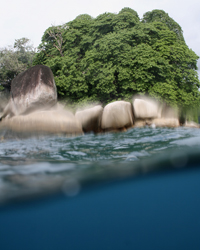
November 7 – 14th, 2006
This reef was also studied by PCRF in 2001 and 2008. Please refer to the links to the 2001 and 2008 studies at the top of each page for comparative data sets.
Fringing
Water temperature was measured four times during the course of this study while diving at average 5 to 10 metres depth by a Cochran Commander dive computer. Three times the temperature was logged at 84 °F (28.9 °C) and once at 85 °F (29.4 °C).
We did not observe bleaching on corals during the study period.
We sighted one table Acropora sp. colony which appeared to be suffering from White Band Disease. This colony was on the north-west side of the island.
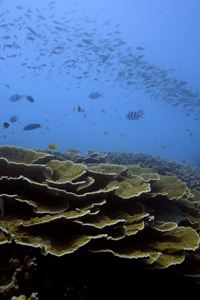
Horizontal visibility just below the surface was measured twice during this study using a Secchi Disk. The results were 32 and 43 feet (9.7 and 13.1 metres respectively). However, estimations of underwater visibility during the study dives were sometimes as low as 7 metres.
Visibility was low, most likely due to it being the North East monsoon season, with short and heavy rainfalls about once a day. However, it is also possible that visibility has been reduced due to runoff from the current development on the island. We know that the resort opposite Renggis Island dynamited the hillside to create flat foundations for new accommodation and that this caused sediment to flow towards Renggis Reef. We also observed during a very heavy rainfall lasting a few hours runoff pouring into Teluk Tekek from the construction site of the new marina. The demarcation line for this runoff was approximately half way between Renggis and the main jetty at Tekek but winds and currents could potentially bring the runoff closer to the reef at Renggis.
We observed high incidence of crown of thorns seastars on this reef. During dives, more than 10 individuals were frequently sighted. We learned from local dive operators that regular cleanups are performed on Renggis as on other reefs in the Tioman Marine Park and the other marine parks on the east coast of Malaysia. The method used is to remove the seastar from the reef, bring it to shore and bury it. This is helping to control numbers and it is believed that this work will stop the reef becoming infested with crown of thorns, which do have the ability to decimate a reef system in a very short period of time.
The corals most prone to damage by crown of thorns appeared to be Acropora spp. colonies, both branching and table lifeforms, and Montipora spp. plates.
However, despite there being a frequent occurrence of damage to these corals, there were no areas which had been completely obliterated by crown of thorns. Perhaps the density of coral coverage on areas of this reef is able to cope with the current level of infestation, with help from the human intervention to manage the problem.
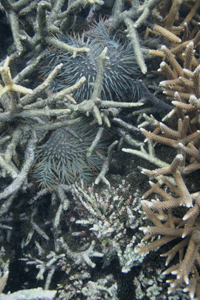
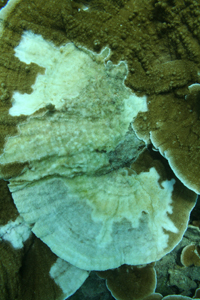
Tioman is the largest of eastern peninsular Malaysia’s islands. It is 13,000 hectares in area and has three main villages. Some say it looks like a turtle, others say a dragon. It boasts two endemic species, a frog and an orchid. It is covered in rich tropical forests and has many trees of impressive diameter. Tioman along with eight other islands and their adjoining coastal waters make up the Tioman Marine Park. The reefs surrounding the island have been declared as the most diverse in Malaysia and Tioman is also the largest marine park in Malaysia.
Tioman was originally a sleepy island of fishing villages. It was first coaxed into the lime light as the site for the filming of South Pacific in the 1950s. Shortly after, Time magazine proclaimed Tioman as one of the world’s ten most beautiful islands. Tourism then started to pick up, and by the 1970s began to flourish. The Marine park was founded in 1994. In 2002 the island was declared a duty free port, giving rise to the several duty free shops, which now dot the road of the western half of the island and advertise with large yellow signs. Until recently the only way to cross the island was by foot or taking a ferry the long way around. A new road is being constructed to link Kampung Tekek on the western side and Kampung Juara on the eastern side. Other projects already underway include the planting of oil palm and rubber plantations in the mountains surrounding Juara and a new marina in Tekek. There is also a proposal for a new airport on the south tip of the island to be built Hong Kong style, with the runway constructed on reclaimed land jutting out into the sea.
A debate is currently underway between local residents, the state government, and the federal government concerning the airport, the marina, and the general approach to the development of Tioman. The marina is currently under construction, while the airport is still in the planning stage. Several Environmental groups including WWF Malaysia have come out against the airport project. Many local people have expressed a general disagreement with the direction of development, which has closely mirrored that in Langkawi, a port on the far side of the peninsula. They argue that their lack of flat land and their abundance of clear waters and pristine reefs could better be utilized with a smaller more environmental brand of development.
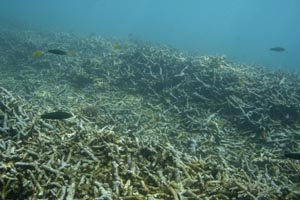
The reef surrounding Renggis reaches to a depth of 10-15 metres. It fringes Renggis Island narrowly on the west side, running off to a sandy slope in which there are many goby/shrimp gardens and scattered small coral bommies. The reef extends the greatest distance from the island to the south side, breaking up from dense coral coverage to more scattered bommies with sand or rubble patches in between.
To the east, the reef is shallow. To the north, the hard coral coverage is the most visually striking and dense – large areas of branching Acropora spp., Porites rus, Echinopora lamellosa, Montipora spp. and Hydnophora spp. It abruptly turns to a flat sand bottom on the north side.
On the north east of the reef, very close to it, an artificial cement reefball project has been initiated. In 2004, 11 reefballs were positioned. There was little hard coral coverage on them observed during our study, however small reef fish (mostly damsels and chromis) aggregated in the area. From the internet, we have learned that 50 more reefballs have just or are about to be installed in the vicinity of Renggis.
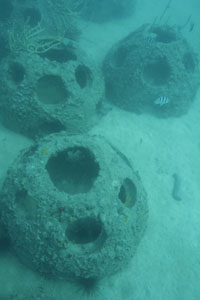
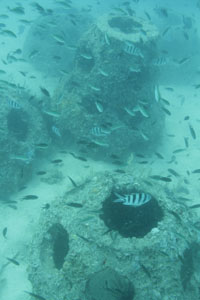
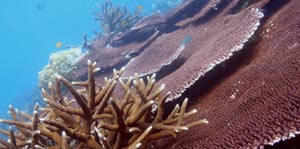
The most vibrant area of the Renggis reef system is the northern section where table Acropora spp. colonies dominate the shallow zone.
Maximum depth here can be as little as 1-2 m at low tide. Here, the table Acropora spp. colonies are large and extremely healthy, some reaching 3 m in width. The most common condition impacting these colonies is broken coral due to wave action but also likely caused by snorkellers and divers on the reef.
Foliaceous Montipora spp. colonies also feature widely in this area of the reef. Colonies are in general extremely healthy, however, there are some colonies which have been heavily damaged by crown of thorns.
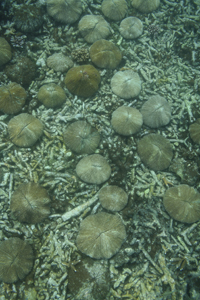
Coral density increases on the gradual slope towards the sand bottom, with fields of branching Acropora spp., Echinopora lamellosa, Echinopora horrida and Porites rus becoming significant in formation and size. Again, in general corals are healthy. Crown of thorns have damaged the lower sections of branching Acropora spp. colonies but it would appear that even with some affliction these corals are still continuing to grow successfully.
On the north west side, there are small areas in which high numbers of Fungia spp. colonies have aggregated, up to 50 in an area of a few square metres.
The eastern area of Renggis reef is reminiscent of a backreef, with broken coral rubble covering much of this section. Small bommies are scattered throughout this area, but most significant here is the presence of Diadema spp. sea urchins which are present in groups of large numbers. These do not seem to be affecting the corals at Renggis and therefore pose no significant threat.
The southern side of Renggis has a diversity of healthy corals in the shallow zone. Rubble patches and more noticeable quantities of dead coral were observed where the reef begins to slope off. These dead corals included many table Acropora spp. colonies.
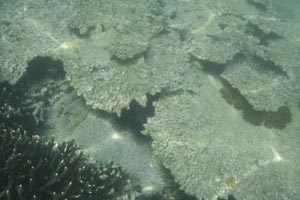
Detrimental Vitareef conditions were scored more frequently here. Overgrowth by filamentous algae, macroalgae and invertebrates were noted. Areas of rubble had new colonies settling successfully.
There is a very large perfectly healthy massive Porites spp. colony on the southwest side.
Comparison of the Vitareef results from 2001 and 2006 show an increase in overall health at Renggis reef. The percentage of healthy colonies rose from 43.7% in 2001 to 63.1% in 2006, and threats to the reef decreased from 53.5% in 2001 to 28.8% in 2006. This alone indicates significant and continued recovery from 2001 to 2006. Filamentous and macroalgae overgrowth have also decreased since 2001 data with more than a 40% drop in this period. Sedimentation on the reef fell by 7% and bleaching was also shown to decrease. It is possible that the condition scored as bleaching in 2001 was in fact fresh damage by crown of thorns seastars. However, crown of thorns damage is still significant, as noted above.
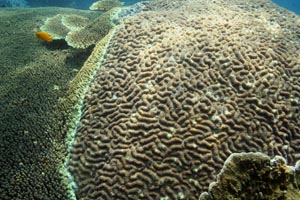
Coral diversity was much lower in the shallow zone (17 genera) compared to the deep zone (29 genera). Acropora was the dominant coral genus in the shallow zone and Echinopora in the deep zone.
Close to the island on the southwest side there is a large boulder upon which three coral species are competing aggressively for space – Acropora sp., Symphyllia sp., and Montipora sp.
While we were conducting our study at Renggis, new moorings were placed around the reef, one of which on the north east side damaged small areas of plate and branching corals.
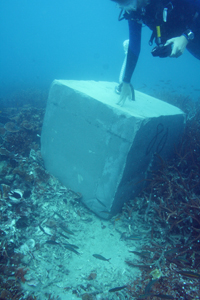
In 2001, two observers recorded fish observations at four sites around the Renggis Reef and logged their observations as separate data sheets. The total number of fish species observed between them was 140.
In 2006, one diver recorded fish observations at two sites. The total number of fish species observed was 73. The lower number of species observed is possibly due to a combination of several factors: - Only one observer recorded fish sightings and on only half the number of dives - The visibility was reduced in 2006 compared to 2001 due to the 2006 study being conducted in the NE monsoon season and the 2001 study being conducted in May after rainy season was over. - It is possible that fishing practices have reduced the number of species on this reef, however, Renggis is part of Tioman Marine Park and is reasonably carefully policed for illegal fishing activities. Thai fishing boats that have operated within gazetted areas of the marine park have been confiscated and sunk within Teluk Tekek to provide substrate for new reefs.
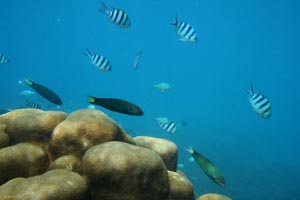
Pulau Renggis is a very popular diving and snorkeling site for tourists in high season. During our first dive in 2006, we watched as a dive boat threw over 50 bread rolls into the water before entering. We have also observed fish feeding in 2001. As a result, the fish and other marine life behaviour on the reef is altered from natural reactions. Scissortail sergeant damsels (Abudefduf sexfasciatus) and crescent wrasses (Thalasoma lunare) are the most curious of the shallow zone fishes.
We did not observe the black tip reef shark that was a very prevalent presence during our 2001 study, usually on the farther south side of the reef. However, we had verbal reports that since 2001, this female had four offspring and is still very present on the reef. There was one sighting of two dogtooth tuna (Gymnosarda unicolor)passing very close to the island. On one dive, we observed a school of yellowtail barracuda (Sphyraena flavicauda) on the west side of the reef.
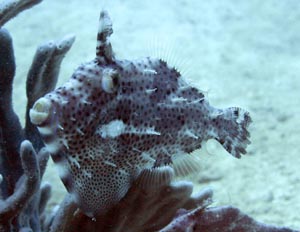
On the west side, in the goby/shrimp sand garden beneath the reef, we observed two strapweed filefish (Pseudomonacanthus macrurus) swimming together, changing colour upon approach by diver. One was approximately 10 cm long, the other about 5 cm.
The abundant and diverse presence of anemones has an associated diversity in anemonefish. Those sighted include the clown anemonefish (Amphiprion percula), pink anemonefish (Amphiprion perideraion), Clark’s anemonefish (Amphiprion clarkii), skunk anemonefish (Amphiprion akallopisos) and the false clownfish (Amphiprion ocellaris).
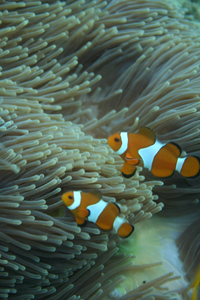
The most commonly observed invertebrate was an unidentified species of corallimorph, seen in almost all areas of the reef system, sometimes in moderate numbers while often in overabundance, blanketing an area. In many instances, the corallimorphs appeared to be encroaching on the living hard coral.
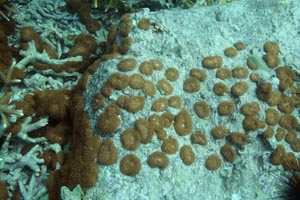
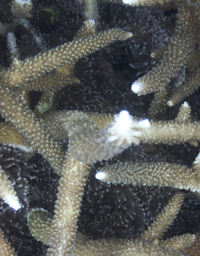
Sea urchins, predominantly Diadema spp., were observed in abundance throughout the area.
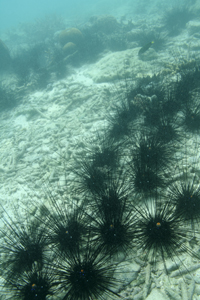
For crown of thorns observations, see crown of thorns section above.
Many species of encrusting sponge were observed, often encroaching on hard corals. A grey sponge is overgrowing branching Acropora spp. colonies, especially on the south side.
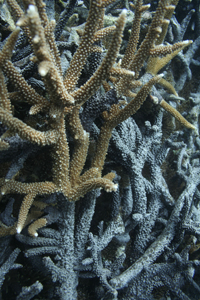
Bivalves are fairly common here, especially scallops in Porites spp. colonies. Giant clams of several species and sizes were observed, predominantly Tridacnus squammosa.
On the south east side, in the sand/rubble areas, a healthy population of sea cucumbers, Holothuria edulis, were noted.
There was some zoanthid overgrowth in the rubble areas on the south side.
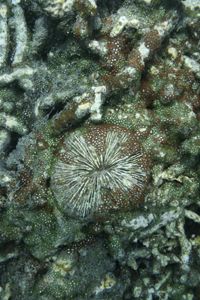
Cuttlefish were sighted several times and were very approachable.
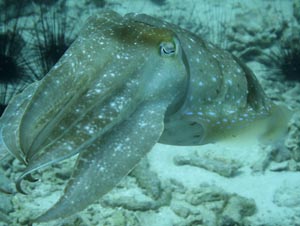
There are many anemones on this reef, especially close to the shallows. Species observed were Heteractis magnifica, Heteractis crispa, Heteractis aurora, Stichodactylus spp. and Entacmaea quadricolor. Some have no clownfish associated with them.
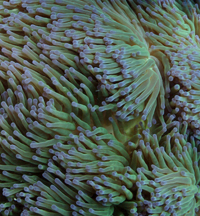
We sighted no marine mammals during our stay in Teluk Tekek. We have heard reports of drastic reductions in the sightings of common dolphin pods in the area of Tioman over the last five or so years.
Six turtle observations were made around Renggis Island within eight days. Three were hawksbills, one was a green, and two were unidentified as they were only seen briefly on the surface. Those seen underwater were slowly moving away from the observer, possibly accustomed to human presence as there is an abundance of tourist diving and snorkeling activity. Although none were observed during our stay, we were told by a resident of Tioman that leatherbacks have also been seen in the area and have nested at Tioman. This resident has also noticed a decline in the number of turtles observed over the years. Regulations to protect the turtles have been put in place and it has become socially unacceptable to harm them. However, while it is illegal to capture and kill turtles, some of the locals still eat the eggs.
The reef around Pulau Renggis has had a long history of threats. It was heavily dynamited before the establishment of the Tioman Marine Park in 1994. When we studied this reef in 2001, we could still clearly see damaged areas which had not yet shaken off the scarring from the destructive fishing. However, this year in 2006, the reef was overall in great health, as reflected in the changes in Vitareef results from 2001 and 2006.
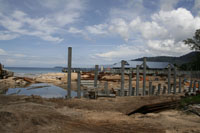
Development is in full swing on the island of Tioman with construction of a marina currently underway and plans to build an airport large enough to handle 737s. There is space on Tioman Island for development, with the major hub right now being Teluk Tekek, spreading gently in a narrow band along the west coast to Salang in the north and the most southern tip of the island. A forest track leads across the island’s peaks to Juara on the east coast.
One of the natural defences that Tioman has is the steepness of its mountains which are currently covered in mostly virgin rain forest. The island currently boasts an endemic species of toad, lizard, gecko and orchid. These slopes rise from just behind the beach leaving development not much room to manoeuvre but should development win the battle against preservation, then the effects of sedimentation could be disastrous to the reefs around Tioman, especially Renggis which sits so close to the coast. Another threat is the crown of thorns outbreak. This is being carefully monitored, with data during cleanups collected by the Marine Park Authorities in Tioman.